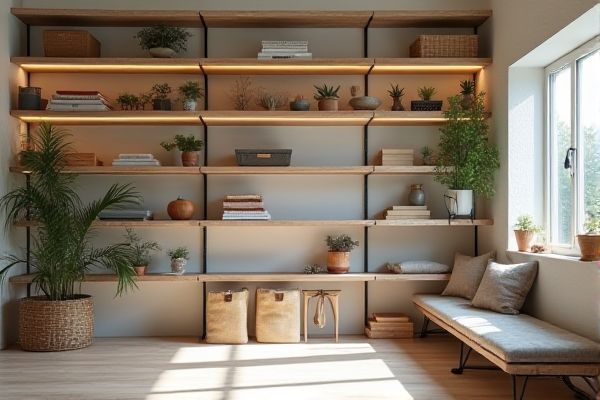
Ventilated shelving improves air circulation, reducing moisture buildup and preventing mold or mildew, making it ideal for food storage or damp environments, whereas solid shelving offers a sturdier, more stable surface perfect for heavy or small items that require full support. Explore this article to discover which shelving type best suits Your specific storage needs.
Table of Comparison
| Feature | Ventilated Shelving | Solid Shelving |
|---|---|---|
| Airflow | Allows airflow for better ventilation | No airflow, solid surface |
| Moisture Control | Reduces moisture buildup | Can trap moisture, leading to mildew |
| Weight Capacity | Generally lower weight capacity | Higher weight capacity |
| Cleaning | Easier to clean, less dust accumulation | Can accumulate dust, harder to clean |
| Best Use Cases | Refrigeration, storage requiring airflow | General storage, heavy items |
| Material | Metal wire or perforated metal | Solid metal, wood, or plastic |
| Appearance | Open, lightweight look | Solid, robust appearance |
Introduction to Ventilated and Solid Shelving
Ventilated shelving features open grids or slats that allow air circulation, reducing moisture buildup and preventing dust accumulation, making it ideal for environments requiring cleanliness and airflow such as commercial kitchens or warehouses. Solid shelving, made from continuous surfaces, provides a sturdy, flat platform for storing small or delicate items that might otherwise fall through ventilated shelves, suitable for offices or retail displays. Choosing between ventilated and solid shelving depends on your storage needs, with ventilated options optimizing airflow and hygiene, while solid shelves maximize stability and versatility.
Key Differences Between Ventilated and Solid Shelving
Ventilated shelving features a wire or mesh design allowing air circulation, reducing moisture buildup and dust accumulation, making it ideal for environments requiring hygiene and airflow, such as commercial kitchens and medical storage. Solid shelving consists of flat, unbroken surfaces offering maximum support and a smooth surface for easy cleaning, favored for storing small items or retail products that need stability and better protection from external contaminants. The key differences lie in airflow capacity, dust control, and load support, with ventilated shelves optimizing ventilation and solid shelves providing enhanced surface integrity.
Material Options for Each Shelving Type
Ventilated shelving typically comes in materials like wire steel, stainless steel, and specialty coated metals, offering durability and airflow to prevent moisture buildup and maintain product freshness. Solid shelving is commonly crafted from materials such as wood, laminate, plastic, or metal, providing a smooth surface ideal for supporting smaller or loose items without risk of slipping through gaps. Your choice between these shelving types should consider the environment and specific material benefits, such as corrosion resistance in ventilated steel or aesthetic appeal in wood solid shelves.
Advantages of Ventilated Shelving
Ventilated shelving offers superior air circulation, reducing moisture buildup and minimizing the risk of mold and mildew, making it ideal for environments requiring cleanliness and hygiene such as commercial kitchens and hospitals. The open design enhances visibility and accessibility, streamlining inventory management and improving safety by preventing dust accumulation and promoting fire prevention. Constructed typically from durable materials like stainless steel or epoxy-coated steel, ventilated shelves provide strength and longevity while supporting heavy loads in industrial and retail settings.
Benefits of Solid Shelving
Solid shelving offers superior support for heavy or small items, preventing objects from slipping through gaps that are common in ventilated designs. It provides a stable surface ideal for storing delicate materials and reduces dust accumulation compared to open ventilation shelves. This type of shelving is particularly beneficial in environments requiring controlled cleanliness and maximum load capacity.
Ideal Uses for Ventilated Shelving
Ventilated shelving excels in environments requiring airflow to prevent moisture buildup, such as in commercial kitchens, food storage, and healthcare settings. Its open grid design facilitates air circulation, reducing the risk of mold, rust, and odors, making it ideal for storing perishable items and cleaning supplies. You benefit from enhanced hygiene and extended shelf life of stored goods when choosing ventilated shelving.
Best Applications for Solid Shelving
Solid shelving is ideal for storing small or loose items that could fall through ventilated slots, such as paper, tools, or electronics. Its flat, continuous surface provides better protection against dust and moisture, making it suitable for environments requiring cleanliness and organization. You'll find solid shelving essential for applications needing a stable, solid base for fragile or delicate equipment.
Maintenance and Cleaning Considerations
Ventilated shelving offers superior airflow that reduces dust buildup and minimizes the risk of mold or mildew, making maintenance and cleaning easier and faster compared to solid shelving. Solid shelving often traps dust and spills on its surface, requiring more frequent and intensive cleaning efforts to maintain hygiene. Choosing ventilated shelving can enhance sanitation in environments such as commercial kitchens, warehouses, and storage areas where cleanliness is critical.
Cost Comparison: Ventilated vs Solid Shelving
Ventilated shelving typically costs less upfront due to lower material usage and simpler manufacturing processes compared to solid shelving, which requires more material and intricate construction. Maintenance expenses are often lower for ventilated shelving because air circulation reduces moisture buildup and associated damage, extending the shelf's lifespan. However, solid shelving may incur higher long-term costs due to increased susceptibility to warping and damage in humid environments, making ventilated shelving a cost-effective option for many industrial and commercial settings.
How to Choose the Right Shelving for Your Needs
Ventilated shelving offers superior air circulation, making it ideal for environments requiring moisture control and cleanliness, such as commercial kitchens and healthcare facilities. Solid shelving provides a flat, stable surface suitable for heavy or small items that could slip through ventilated gaps, often preferred in retail and storage settings. Assessing the specific storage needs, including item type, weight capacity, and environmental factors, ensures the right shelving choice aligns with functionality and efficiency.
 homyna.com
homyna.com